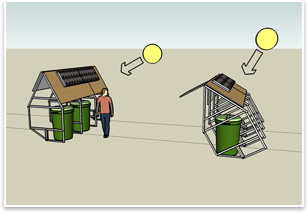
A Mile Is Worth a Penny
by Russell Boniface
Summary: One year ago, Boston architect Paul Brown, AIA, LEED-AP, started a new non-profit organization called One Penny Per Mile, based on the concept that automobile drivers who want to reduce their carbon footprint or, as Brown says, “offset their carbon usage in a meaningful way,” contribute a penny to One Penny Per Mile for every mile they drive. One Penny Per Mile, in turn, will use the money to design, construct, and install renewable energy systems, such as photovoltaics, at local public locations that will include schools. One Penny Per Mile has been incorporated, achieved 5013c status, conducted an initial round of fundraising, established a board of directors, and is currently installing its first renewable energy system at The Walker Home and School in Needham, Mass. “We’re off and running,” says Brown. “I decided this is where I would like to take my career.” Brown says that while in school in the ‘70s, he was captivated by solar design on a residential scale. Four years ago, he became involved in the sustainable design movement by taking a job as project manager for one of the first green schools in Massachusetts, which received a grant to add green features, including a large photovoltaic array. He became LEED®-accredited and last year founded the nonprofit One Penny Per Mile. The concept With the money raised, One Penny Per Mile will design, construct, and install renewable energy systems free of charge for local public organizations, such as schools. Each installation will include educational signage describing the system’s parts and, when possible, feature an interactive computer that monitors energy production under varying weather conditions. One Penny Per Mile currently works out of Brown’s house and has no employees, but, as Brown describes, is currently running on his volunteer labor and help from friends serving as the board of directors. “They are long-term friends whose wisdom I respect. Eventually, as One Penny Per Mile grows, I will fill the role as executive director. We have done an initial round of fundraising, which basically boiled down to my family and friends.” A leap of faith Brown says the grant-writing process will eventually be a factor to ascertain funding for the One Penny Per Mile energy systems’ installations. “I had thought of doing it that way at first, thinking that that is the more fiscally responsible way to do it. But we felt that we needed to demonstrate something as a fundraising resource to get started. Later on, as we mature and get more work under our belts, it probably won’t be so much of an issue, but for right now our feeling was that we start with a demonstration.” A photovoltaic demonstration “These are kids from unfortunate family backgrounds and/or have learning disabilities, who are within a residential program. I’m currently a mentor to a student there. Our current estimate of the cost of the project, which One Penny Per Mile will fund, is $6,000, furnished and installed, including extensive carpentry work. The cost of the system itself is about $2,100. We will not actually be giving the school any money. One Penny Per Mile currently has a donated fund balance of about $1,500, so we’ll need to raise an additional $4,500 in order to complete this first project.” |
||
Copyright 2008 The American Institute of Architects. All rights reserved. Home Page |
||
home
news headlines
practice
business
design
recent related
› LEED 2009 Now Open for Public Comment
› Nouvel’s “Green Blade” Takes Root
› Photovoltaics and Wind Turbines Infuse Colorado Development
Visit the One Penny Per Mile
Web site.
See what the AIA Committee on the Envrionment is up to.
Paul Brown’s idea for the Walker School project: An exterior recycling center, with sheltered storage for recycling bins, and PV-powered lights (important when in the winter). The image shows the structural frame with the PV panel frames on the south side 'roof' at a 60 degree slope for winter operation when the sun is lower in the sky. In the summer, when the sun is higher in the sky, the entire unit rotates back by 30 degrees, so that the PV panels are now at a 30-degree angle; much better for PV performance. PV panels might also power a trash compacter, paper shredder, or other devices.

 How do you . . .
How do you . . .